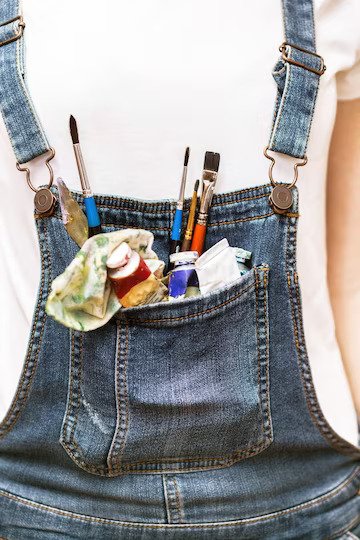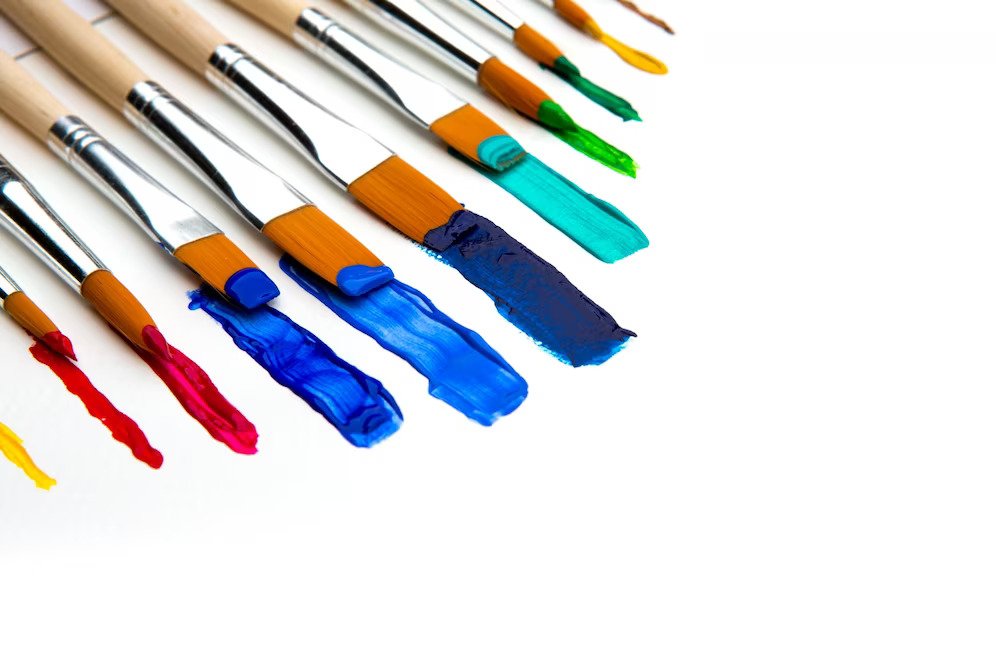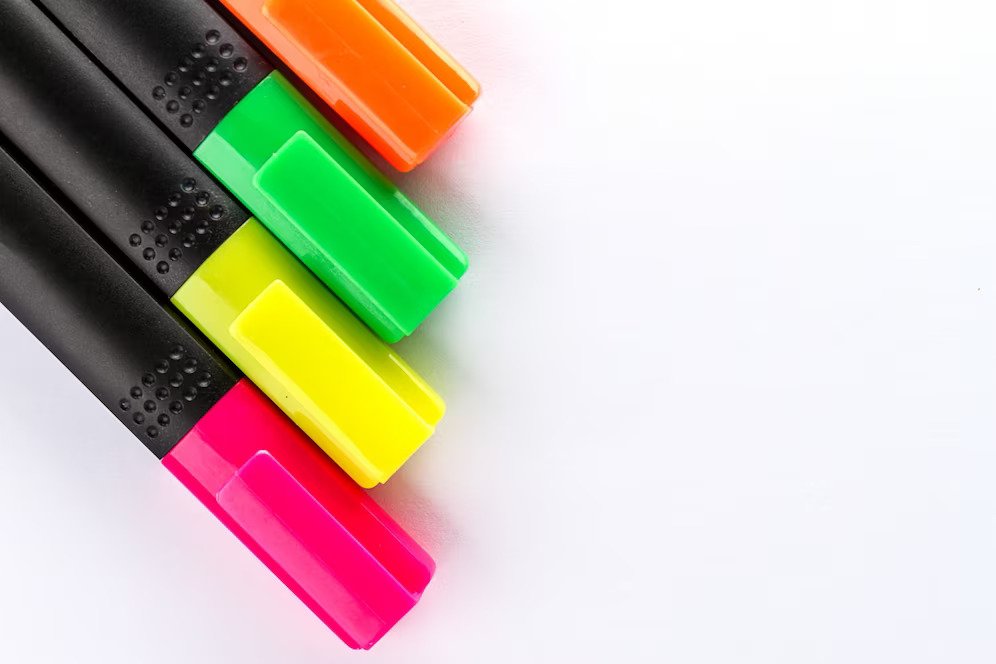Painting with acrylic paint is fun. It is even more fun when you want to paint your old jeans or denim shorts. I know you have probably used acrylic paint before. Whether is was painting on Canva, walls, stones, or wood – it turned out great. However, when it comes to painting jeans with acrylic paint, you may have some reservations. Well, I am here to tell you that you can definitely use acrylic paint on jeans. However, you need to mix it with a fabric medium.
Painting jeans with acrylic paint and a fabric medium ensures a vibrant consistency that adhere well to the fabric, resist cracking, and maintain flexibility. A fabric medium will also make the acrylic paint durable making your jeans long-lasting and comfortable to wear.
Acrylic paint is one sure way to add some creative sparks to your jeans .In this blog, you will learn how to prepare your jeans for better acrylic paint adhesion. You will also learn how to seal it for that shiny and glossy look. For this tutorial, I will be painting on denim jean’s pockets using acrylic paint. Let’s get started?
Related Reading
- The Best Acrylic Paints
- Can You Use Acrylic Paint on Fabric?
- Can You Use Acrylic Paint on Metal?
- Can You Use Acrylic Paint on Shoes?
How to Paint Acrylic Paint on Jeans?
Materials Needed
- Acrylic Paint ( I recommend Nicpro 14 Colors Large Bulk Acrylic Paint Set (16.9 oz,500 ml and Shuttle Art Acrylic Paint, 15 Colors Acrylic Paint Large Bottle Set)
- Jeans
- Fabric Medium( liquitex fabric medium is my favorite)
- Working Table
- Paintbrushes or sponges
- Painter’s tape (optional)
- Palette or disposable plate
- Iron for Heat Setting
- Ironing board or cloth
- Fabric sealant (optional)
- Water and a container for cleaning brushes
Instructions
Step 1: First things First, Get Your Jeans Ready For Acrylic Paint

Its quiet simple- Just like painting acrylic paint on Pumpkins, you should always wash and dry your jeans to remove any dirt or residues that might interfere with the paint’s adhesion. I suggest you iron the jeans to ensure they are smooth and ready for painting. This makes it really easy to paint on. By the way, acrylic paint is non- toxic. You can safely use it on skin, fabric, leather. Matter of facts- It is absolutely non-toxic for dogs.
Step 2: Mix Your Acrylic Paint with Fabric Medium

In a palette or disposable plate, mix the acrylic paint with fabric medium. Start with the recommended ratio which is 1 part fabric medium for every 2 parts of acrylic paint. Stir the mixture thoroughly enough to ensure it’s well combined(Keep in mind that fabric medium will not dilute your acrylic paint, it will just thin it a little).
Step 3: Plan Your Design (Optional) and Apply Painter’s Tape
If you have a specific design in mind, you can sketch it lightly on the jeans using a pencil or use painter’s tape to create guidelines for straight lines or geometric patterns. Next, apply Painter’s Tape. Carefully apply painter’s tape along the areas where you want to create clean edges or block off from the paint. Press the tape firmly to ensure it adheres well to the fabric.
Step 4: Apply Layers of White Paint Before Painting, then You Can Apply Acrylic Paint
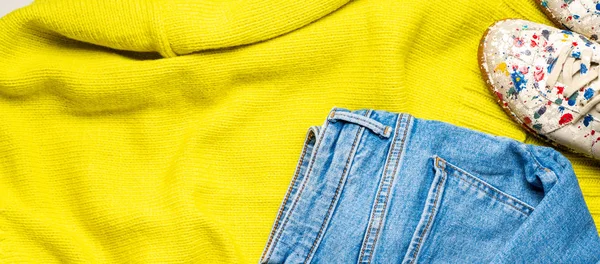
Apply layers of white paint as a base for painting on jeans . This is recommended for black or darker jeans Adding a layer of white paint as a base can significantly improve the vibrancy and opacity of the colors on dark denim. Next, dip your paintbrush or sponge into the acrylic paint mixed with fabric medium and start applying it to the jeans. In all honesty, I think you should also experiment with neon colors, checkout the Top 10 Best Neon Acrylic Paints to make your jeans glow in the dark. You can try out various techniques to create your desired design. You can also layer colors to achieve different shades and textures.
Step 5: Let the Paint Dry
Allow the paint to dry completely before proceeding to add additional layers. Acrylic paint can dry very fast , roughly between 20 -2 hours depending on how thick your paint is. Be patient about it.
Step 6: Once your Paint is Dry , Heat Set the Paint
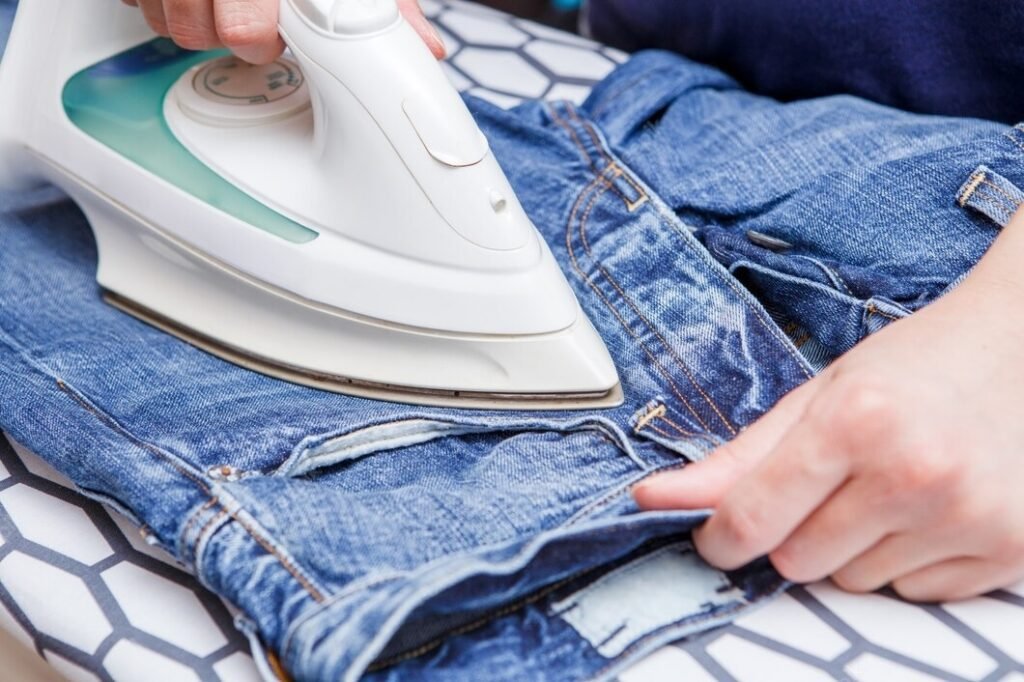
Once the paint is dry, turn the jeans inside out and place a cloth or a piece of parchment paper on top to protect the painted surface. Using an iron on the appropriate setting for the fabric (usually cotton), gently press the iron over the painted area for about 2-5 minutes. Heat-setting process will help the paint bond better to the fabric and make it more durable.( This is one of the steps you must not miss if you want your acrylic paint to last longer on your jeans)
Step 7: Apply Fabric Sealant ( Optional )
If you want extra protection for your painted design, you can apply a fabric sealant over the painted area. Fabric sealants come in all forms such as ; spray or brush-on form.
Step 8: Final Touches
Once the sealant is dry, inspect your painted jeans for any touch-ups or additional details you might want to add. Make any necessary adjustments with the acrylic paint.
Step 9: Care and Washing
Turn the jeans inside out before washing to protect the painted surface. Hand wash the jeans or use a gentle cycle on your washing machine with cold water. Avoid using bleach or harsh detergents, as they may affect the painted design. After washing, let the jeans air dry. There you have it, by following these steps, you can create your personalized and durable painted jeans using acrylic paint mixed with fabric medium.
Best Overall Fabric Paint( ARTEZA Fabric Paint for Clothes)

How Do You Seal Acrylic Paint on Denim?
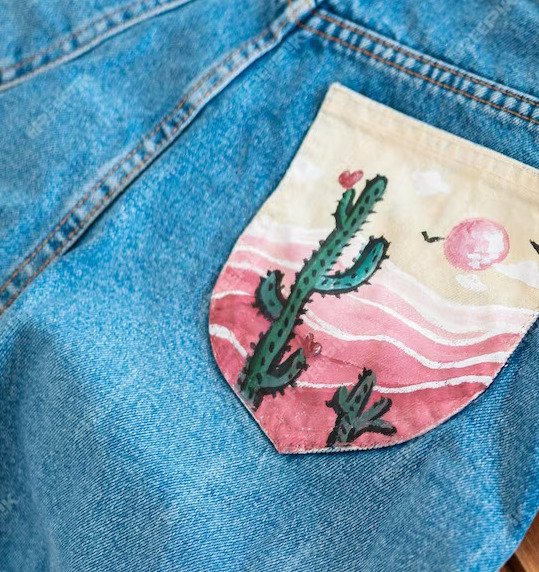
When it comes to sealing acrylic paint on denim, there are two primary methods: using a fabric sealant and heat setting the paint.
1) Fabric Sealant
Using a fabric sealant is an option for adding an extra layer of protection to the painted surface. Fabric sealants come in spray or brush-on form and create a clear protective barrier over the painted area. A fabric sealant will also help to minimize fading, resist water, and reduce the risk of paint chipping or rubbing off.
2) Heat Setting
Heat setting involves applying heat to the painted surface, which helps to bond the acrylic paint molecules with the fabric fibers. Heat setting increases the paint’s adhesion and makes it more resistant to washing, fading, and general wear overall.
Why Heat Setting is the Best Option?
While both methods can provide some level of protection, heat setting is often considered the best option for ensuring the paint’s durability and longevity on denim. Here’s why:
- Permanence: Heat setting creates a more permanent bond between the paint and the fabric, ensuring that the design remains intact even after multiple washes and extended use.
- Flexibility: Unlike some fabric sealants that can make the painted area stiff or rigid, heat setting retains the fabric’s flexibility, making the painted jeans comfortable to wear.
- Easy Application: Heat setting is a straightforward process that can be done with a household iron. It doesn’t any require additional products. What’s more- you can do it at home by your self without the need for specialized equipment.
- Cost-effective: Heat setting doesn’t require purchasing additional sealants, making it a cost-effective way to seal acrylic paint on denim.
How to Heat Set Acrylic Paint on Denim?
Here’s how to heat set acrylic paint on denim:
- Allow the painted design to dry completely on the denim.
- Turn the denim inside out to protect the painted surface.
- Place a cloth or a piece of parchment paper over the painted area.
- Set your household iron to the appropriate temperature for the fabric (usually the cotton setting).
- Gently press the hot iron over the painted area, moving it continuously for about 2-5 minutes. Avoid using steam during this process.
- Allow the denim to cool down, and your heat setting is complete.
By heat setting acrylic paint on denim, you definitely enhance the paint’s longevity and make it more resistant to washing and everyday use.
Can I Paint Acrylic Paint on Denim Without Fabric Medium?
| Benefit | Acrylic Paint + Fabric Medium | Acrylic Paint Only |
|---|---|---|
| Better Adhesion | ✔️ | ❌ |
| Improved Flexibility | ✔️ | ❌ |
| Reduced Cracking by 80 % | ✔️ | ❌ |
| Enhanced Durability | ✔️ | ❌ |
| Comfortable to Wear | ✔️ | ❌ |
| Vibrant- Shiny Colors | ✔️ | ❌ |
| Long-Lasting Designs | ✔️ | ❌ |
| Resists Washing Damage | ✔️ | ❌ |
It is possible to paint acrylic paint on denim without fabric medium, there are some important considerations you should be aware of. The “considerations” in this case refers to the potential limitations and drawbacks of using acrylic paint on denim without fabric medium:
- Texture: When acrylic paint is used directly on denim without fabric medium, it can result in a stiffer texture once the paint dries. This stiffness might not be as comfortable to wear, And ,especially in areas of the fabric that require flexibility, such as knees or elbows.
- Durability: Acrylic paint on denim without fabric medium might not be as durable as when mixed with fabric medium. Without the fabric medium, the paint may not fully adhere to the fabric fibers, leading to a higher risk of cracking or peeling over time, particularly with repeated washing and wear.
- Color Vibrancy: Using acrylic paint without fabric medium could affect the vibrancy of the colors on denim. The paint may not bond as effectively to the denim fibers, which could result in colors appearing less vibrant or slightly muted.
- Washability: Acrylic paint without fabric medium may not be as wash-resistant as when fabric medium is used. Colors might fade more quickly with regular washing, especially in the absence of a proper bonding agent provided by fabric medium.
- Comfort: The stiffness of acrylic paint without fabric medium might make the painted areas less comfortable to wear, particularly if you’re using thick layers of paint or painting on areas that require flexibility, like the waistband or cuffs.
- Cracking: Without fabric medium, the paint may have a higher tendency to crack, especially if the denim fabric experiences frequent bending or stretching.
To address these potential issues and achieve better results, you can try the following tips:
- Solution 1: Thin Layers– Apply the acrylic paint in thin layers to minimize stiffness and allow for better adhesion to the denim.
- Solution 2: Allow Drying Time– Ensure each layer of acrylic paint dries completely before adding more layers or starting a new design. This helps improve the paint’s bonding with the fabric.
- Solution 3: Heat Setting– After the acrylic paint has dried, heat set it with an iron to enhance adhesion and increase its resistance to washing.
- Solution 4: Hand Wash or Gentle Cycle -To prolong the life of your painted denim, consider hand washing the garment or using a gentle cycle with cold water when machine-washing.
Will Acrylic Paint Wash Off of Jeans?
Acrylic paint is water- based , meaning that it can easily wash off without proper sealing or preparation. It is not entirely wash-resistant. Over time, with repeated washing and wear, the paint could fade, crack, or even wash off to some extent. There are ways to make acrylic paint last longer on jeans, see details below;
How Do You Make Acrylic Paint Last on Jeans?
Here are ways to make acrylic paint more permanent on jeans to ensure it doesn’t wash out easily:
- Apply a Fabric Medium
Mixing acrylic paint with fabric medium before applying it to the jeans is one of the most effective ways to improve adhesion and permanence. Fabric medium helps the paint bond with the fabric fibers, making it more flexible and durable, even after washing. - Use Heat Setting
After the paint has dried on the jeans, heat setting is crucial to improve its wash resistance. Place a cloth or parchment paper over the painted area, turn the jeans inside out, and use a hot iron to apply gentle pressure for about 2-5 minutes. Heat setting makes the paint molecules fuse with the fabric, making it more permanent and wash-resistant. - Apply acrylic Paint in Thin Layers
Apply acrylic paint in thin layers rather than thick globs. Thinner layers have better adhesion and are less likely to crack or peel when the fabric bends or stretches. - Allow Sufficient Drying Time
Ensure each layer of paint dries completely before adding additional layers or starting a new design. Proper drying time allows the paint to adhere better to the fabric. - Avoid Harsh Detergents and Bleach
When washing your painted jeans, avoid using harsh detergents or bleach, as they can accelerate paint fading. Instead, opt for a gentle detergent and wash in cold water. - Hand Wash or Gentle Cycle
To prolong the life of your painted jeans, consider hand washing them or using a gentle cycle with cold water in the washing machine. Turn the jeans inside out before washing to protect the painted surface. - Air Dry
Always air dry the jeans instead of using a dryer. High heat from the dryer can damage the paint and cause it to crack or fade more quickly. - Fabric Sealant (Optional)
If you want an extra layer of protection, apply a fabric sealant over the painted area. Fabric sealants will help improve the paint’s durability and resistance to washing.
Try out These Painting Jeans Ideas






Images source: Pinterest
Frequently Asked Questions
How Long Does Acrylic Paint Take to Dry on Denim?
Dry to touch: 1 to 2 hours while full cure takes 24 to 48 hours or longer
How Can I Turn Acrylic Paint Into Fabric Paint?
Acrylic paint can be transformed into fabric paint by adding a fabric medium. Fabric mediums are designed to mix with acrylic paint, making it more flexible and suitable for painting on fabrics. Mix with 1 part of fabric medium to 2 parts of acrylic paint (1:2 ratio).
Does Acrylic Paint Stay On Denim Jeans?
Absolutely, if prepared and cared for properly, acrylic paint can last much longer on denim jeans. Just make sure you use a fabric medium .
Can I Use Acrylic Paint on Jeans?, What Kind Can I Use on Denim Jeans?
Acrylic paint is the easiest to work with if you want to paint your denim jeans. You can easily thin out acrylic paint with water or a fabric medium to achieve the right consistency.
Final Thoughts
Just like applying acrylic paint on Canva or wood, the right preparations are key. The most important is the use of a fabric medium, just like premier, a fabric medium will make sure your acrylic paint on jeans sticks well enough and prevents cracking in the long run. You can definitely paint your jeans without a fabric medium but why take the risks. Get your self a fabric medium to make things easier.


